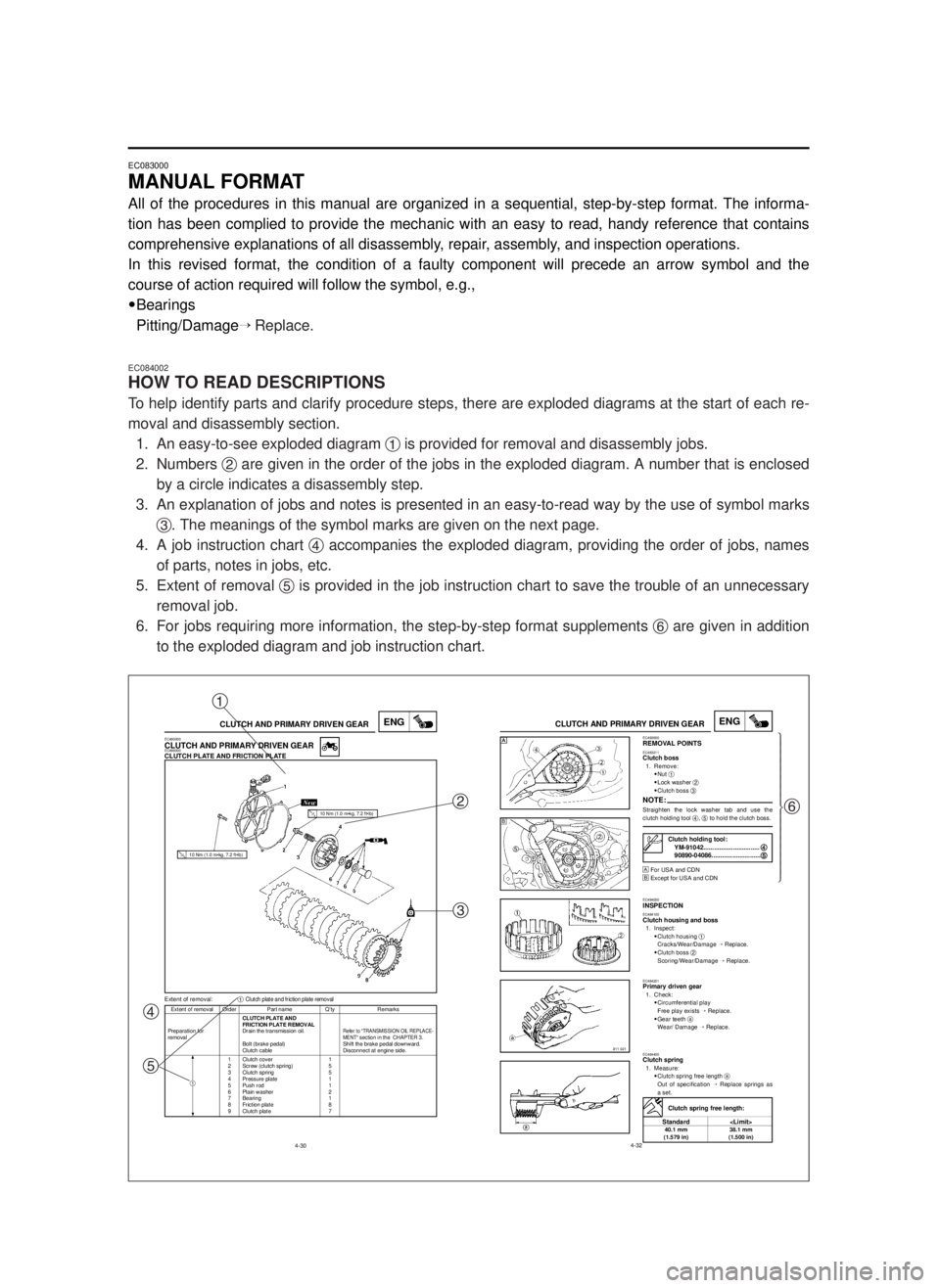2001 YAMAHA YZ125LC low oil pressure
[x] Cancel search: low oil pressurePage 14 of 558

EC083000
MANUAL FORMAT
All of the procedures in this manual are organized in a sequential, step-by-step format. The informa-
tion has been complied to provide the mechanic with an easy to read, handy reference that contains
comprehensive explanations of all disassembly, repair, assembly, and inspection operations.
In this revised format, the condition of a faulty component will precede an arrow symbol and the
course of action required will follow the symbol, e.g.,
9Bearings
Pitting/DamageÕReplace.
EC084002
HOW TO READ DESCRIPTIONS
To help identify parts and clarify procedure steps, there are exploded diagrams at the start of each re-
moval and disassembly section.
1. An easy-to-see exploded diagram 1is provided for removal and disassembly jobs.
2. Numbers 2are given in the order of the jobs in the exploded diagram. A number that is enclosed
by a circle indicates a disassembly step.
3. An explanation of jobs and notes is presented in an easy-to-read way by the use of symbol marks
3. The meanings of the symbol marks are given on the next page.
4. A job instruction chart 4accompanies the exploded diagram, providing the order of jobs, names
of parts, notes in jobs, etc.
5. Extent of removal 5is provided in the job instruction chart to save the trouble of an unnecessary
removal job.
6. For jobs requiring more information, the step-by-step format supplements 6are given in addition
to the exploded diagram and job instruction chart.
4-30
ENGCLUTCH AND PRIMARY DRIVEN GEAR
Extent of removal Order Part name Q’ty Remarks
CLUTCH PLATE AND
FRICTION PLATE REMOVAL
Preparation for Drain the transmission oil.
Refer to “TRANSMISSION OIL REPLACE-removalMENT“ section in the CHAPTER 3.Bolt (brake pedal) Shift the brake pedal downward.
Clutch cable Disconnect at engine side.
1 Clutch cover 1
2 Screw (clutch spring) 5
3 Clutch spring 5
4 Pressure plate 1
5 Push rod 1
6 Plain washer 2
7 Bearing 1
8 Friction plate 8
9 Clutch plate 7
Extent of removal:1Clutch plate and friction plate removal
EC490000CLUTCH AND PRIMARY DRIVEN GEAREC498000CLUTCH PLATE AND FRICTION PLATE
1
10 Nm (1.0 m•kg, 7.2 ft•lb)
10 Nm (1.0 m•kg, 7.2 ft•lb)
4-32
ENGCLUTCH AND PRIMARY DRIVEN GEAREC493000REMOVAL POINTSEC483211Clutch boss1. Remove:
9Nut 1
9Lock washer 2
9Clutch boss 3
NOTE:Straighten the lock washer tab and use the
clutch holding tool 4, 5to hold the clutch boss.
Œ
For USA and CDN
º
Except for USA and CDN
EC494000INSPECTIONEC484100Clutch housing and boss1. Inspect:
9Clutch housing 1
Cracks/Wear/Damage Õ Replace.
9Clutch boss 2
Scoring/Wear/Damage ÕReplace.
EC484201Primary driven gear1. Check:
9Circumferential play
Free play exists ÕReplace.
9Gear teeth a
Wear/ Damage ÕReplace.
EC484400Clutch spring1. Measure:
9Clutch spring free length a
Out of specification ÕReplace springs as
a set.
Clutch holding tool:
YM-91042................................4 4
90890-04086............................5 5
Clutch spring free length:
Standard
40.1 mm 38.1 mm
(1.579 in) (1.500 in)
Œ
ºŒü
ï
ï
ï
ï
ï
ï
ï
ý
ï
ï
ï
ï
ï
ï
ï
þ
1
2
3
4
56
5MV-9-30-0 6/19/00 2:05 PM Page 12
Page 134 of 558

3-4
PRE-OPERATION INSPECTION AND MAINTENANCE
INSP
ADJ
EC320000
PRE-OPERATION INSPECTION AND MAINTENANCE
Before riding for break-in operation, practice or a race, make sure the machine is in good operating
condition.
Before using this machine, check the following points.
EC321000
GENERAL INSPECTION AND MAINTENANCE
Item Routine Page
Coolant Check that coolant is filled up to the radiator filler cap.
Check the cooling system for leakage.P3-5~9
Fuel Check that a fresh mixture of oil and gasoline is filled in
the fuel tank. Check the fuel line for leakage.P1-12
Transmission oil Check that the oil level is correct. Check the crankcase
for leakage.P3-12~14
Gear shifter and clutch Check that gears can be shifted correctly in order and
that the clutch operates smoothly.P3-9
Throttle grip/Housing Check that the throttle grip operation and free play
are correctly adjusted. Lubricate the throttle grip and P3-10~11
housing, if necessary.
Brakes Check the play of front brake and effect of front and
rear brake.P3-17~23
Chain Check chain slack and alignment. Check that the chain
is lubricated properly.P3-24~26
Wheels Check for excessive wear and tire pressure. Check for
loose spokes and have no excessive play.P3-34~35
Steering Check that the handlebar can be turned smoothly and
have no excessive play.P3-35~36
Front forks and Check that they operate smoothly and there is no oil
rear shock absorber leakage.P3-26~33
Cables (wires) Check that the clutch and throttle cables move smooth-
ly. Check that they are not caught when the handlebars —
are turned or when the front forks travel up and down.
Muffler Check that the muffler is tightly mounted and has no
cracks.P3-15~16
Sprocket Check that the driven sprocket tightening bolt is
not loose.P3-24
Lubrication Check for smooth operation. Lubricate if necessary. P3-37
Bolts and nuts Check the chassis and engine for loose bolts and nuts. P1-16
Lead connectors Check that the CDI magneto, CDI unit, and ignition coil
are connected tightly.P1-6
Settings Is the machine set suitably for the condition of the
racing course and weather or by taking into account the
P7-1~24
results of test runs before racing? Are inspection and
maintenance completely done?
5MV-9-30-3A 6/19/00 1:52 PM Page 14
Page 474 of 558

5-60
CHASREAR SHOCK ABSORBER
EC586000
HANDLING NOTE
w
This shock absorber is provided with a
separate type tank filled with high-pressure
nitrogen gas. To prevent the danger of ex-
plosion, read and understand the following
information before handling the shock ab-
sorber.
The manufacturer can not be held respon-
sible for property damage or personal in-
jury that may result from improper han-
dling.
1. Never tamper or attempt to disassemble
the cylinder or the tank.
2. Never throw the shock absorber into an
open flame or other high heat. The shock
absorber may explode as a result of ni-
trogen gas expansion and/or damage to
the hose.
3. Be careful not to damage any part of the
gas tank. A damaged gas tank will impair
the damping performance or cause a
malfunction.
4. Take care not to scratch the contact sur-
face of the piston rod with the cylinder;
or oil could leak out.
5. Never attempt to remove the plug at the
bottom of the nitrogen gas tank. It is very
dangerous to remove the plug.
6. When scrapping the shock absorber, fol-
low the instructions on disposal.
EC587000
NOTES ON DISPOSAL (YAMAHA DEAL-
ERS ONLY)
Before disposing the shock absorber, be sure to
extract the nitrogen gas from valve 1. Wear eye
protection to prevent eye damage from escaping
gas and/or metal chips.
w
To dispose of a damaged or worn-out
shock absorber, take the unit to your
Yamaha dealer for this disposal procedure.
5MV-9-30-5D 6/19/00 1:26 PM Page 18
Page 496 of 558

7-1
TUNSETTING
EC700000
TUNINGEC710000
ENGINEEC711001
Carburetor setting
9The role of fuel is to cool the engine, and in the
case of a 2-stroke engine, to lubricate the
engine in addition to power generation.
Accordingly, if a mixture of air and fuel is too
lean, abnormal combustion will occur, and
engine seizure may result. If the mixture is too
rich, spark plugs will get wet with oil, thus mak-
ing it impossible to bring the engine into full play
or if the worst comes to the worst, the engine
may stall.
9The richness of the air-fuel mixture required for
the engine will vary with atmospheric conditions
of the day and therefore, the settings of the car-
buretor must be properly suited to the atmos-
pheric conditions (air pressure, humidity and
temperature).
9Finally, the rider himself must make a test-run
and check his machine for conditions (pick-up
of engine speed, road surface conditions) and
for the discoloration of the spark plug(s). After
taking these into consideration, he must select
the best possible carburetor settings.
It is advisable to make a note of settings,
atmospheric conditions, road surface condition,
lap-time, etc. so that the memorandum can be
used as a reference useful for future.
EC712000
Atmospheric conditions and carburetor
setting
The reason for the above tendency is that the
richness or leanness of a fuel mixture depends
on the density of the air (i.e. the concentration of
oxygen in it).
Air
Air temp. Humidity pressure Mixture Setting
(altitude)
High HighLow
Richer Leaner
(high)
Low LowHigh
Leaner Richer
(low)
7
5MV-9-30-7A 6/19/00 1:24 PM Page 2
Page 498 of 558

7-2
TUNSETTING
That is:
9Higher temperature expands the air with its
resultant reduced density.
9Higher humidity reduces the amount of oxygen
in the air by so much of the water vapor in the
same air.
9Lower atmospheric pressure (at a high altitude)
reduces the density of the air.
EC713001
Test run
After warming up the engine equipped with the
standard type carburetor(s) and spark plug(s),
run two or three laps of the circuit and check the
smooth operation of the engine and discoloration
of spark plug(s).
ŒNormal
ºOver burned (too lean)
Oil fouled (too rich)
Discoloration Condition of spark plug
NormalInsulator is dry and
burnt brown.
Over burned
Insulator is whitish.
(too lean)
Oil fouled Insulator is sooty and
(too rich) wet.
A
B
C
5MV-9-30-7A 6/19/00 1:24 PM Page 4